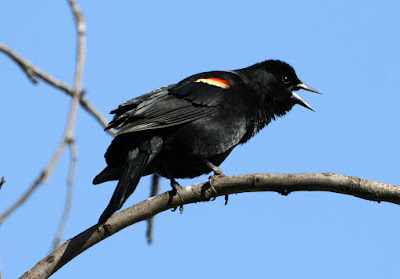 |
| Red-winged blackbird/Chuck Slusarczyk Jr. |
New birders enjoy the beauty of Spring Migration at Cleveland lakefront preserve
One of the greatest rewards
for being a birder is sharing my love for these beautiful plumed
creatures with non-birders, especially while exploring some of the
best birding habitats found anywhere in Northeast Ohio.
My
most recent opportunity to serve as a tour guide and birding
ambassador came May 5
on behalf of the Fairview
Park Women’s Club, http://www.fairviewparkwomensclub.org/
a
philanthropic organization that does amazing work helping
needy families, sponsoring
sports teams and providing scholarships and grants to promising high
school students.
 |
| Blue-headed vireo |
This
year, the Women’s Club raised more than $13,000 in
charitable contributions,
with
a
large chunk of
it coming from
the
annual Wine Tasting & Silent Auction, to which I had donated a
bird walk. The winning bid was cast by Diane
Faile, who invited along about a dozen of
her friends
for a morning walk at one of the birdiest parks in the area, the
Cleveland Lakefront Nature Preserve. Another
talented birder, Karen Lakus, joined us to help everyone see the
birds.
Few
of the participants had ever been on a bird walk before, and none had
previously visited the nature preserve, which made the three-hour
morning walk all the more exciting. Thankfully, the birds and the
weather cooperated.
 |
| Hermit thrush/Chuck Slusarczyk Jr. |
The
month of May in Ohio marks the peak
of the Spring Migration, a thrilling annual phenomenon that
occurs when millions of songbirds that spent the winter in Central
and South America, and the southern U.S., fly en masse northward to
their traditional nesting grounds. Many of the colorful birds pass
through Ohio, often congregating along the Lake Erie shoreline, where
they rest and feed before resuming their journey across
the lake to Canada.
One
of the best
natural rest stops is the lakefront nature preserve, an 88-acre
peninsula formed from decades of sediment dredged from the Cuyahoga
River and Cleveland Harbor and
dumped into a dike surrounded by metal walls and boulders.
Over
the years, trees,
shrubs and plants grew naturally in
the earthen storage dike,
and the migrating birds took advantage of the man-made oasis.
 |
| Embarking on the birding tour |
Our
tour group appeared to genuinely enjoy our many encounters with
whistling Baltimore orioles, sweet singing rose-breasted grosbeaks,
meowing gray catbirds, and recently arrived warblers such as
Nashville, ovenbird, palm, yellow, and common yellowthroat. These
species
were complemented by blue-headed vireos, red-breasted nuthatches,
blue-gray gnatcatchers, ruby-crowned kinglets, and house wrens.
Thrush
were plentiful on
our walk,
including wood, hermit and veery, as
well as
sparrows, notably white-crowned, white-throated, swamp, Lincoln’s,
Savannah, field, chipping, song, and Eastern towhee.
Even
the ubiquitous red-winged blackbirds enthralled the group,
entertaining them with their repertoire of songs and squawks, their
courtship displays, and flaring of red shoulder epaulettes. Brown
thrashers, Northern mockingbirds and Northern flickers joined the
ornithological
chorus.
 |
| Scanning the harbor for loons |
It
was safe to say that none of the tour group had ever experienced such
close encounters
with common loons, three of which paddled leisurely in the harbor
that adjoins the Gordon Park Marina. A horned grebe dove repeatedly
in the lake in pursuit of fish, and a bald eagle passed overhead with
its prey grasped in its talons. More than a dozen wild turkeys
strutted inside and outside the fence, featuring
several
excited Toms with their tails fanned.
I
don’t
know
if anyone on the tour planned to buy a new pair of binoculars or join
any of the morning
bird
walks planned for the remainder of the spring migration in the
Cleveland area. But if even one participant becomes
hooked on this fascinating hobby, my bird walk donation would have
been worth it.
Aerial
View Redux story update:
I
recently
reported a good news bird story in which the developers of an $11
million restoration project of the historic Forest City Bank building
in Ohio City put their
completion of the work
on hold after discovering a pair of American kestrels with five eggs
secreted in the attic behind a hole in a roof
soffit.
I’m
pleased to announce that the eggs have HATCHED, and five fluffy
chicks are now occupying the nest in the old
brick building at the intersection of Detroit Avenue and West 25th
Street.
Primary
credit for the falcons’ success goes to project
manager Walt Gachuk of
the Snavely Building Group, who is supervising the building
restoration and construction of
the
38-unit, Forest City Square Apartments, which will offer low-income
housing in a green building with solar panels on the roof.
The
nature-loving Gachuk has taken his appreciation for the falcons a
step further, setting up a nest-cam inside the attic for birders to
follow the falcon chicks as they mature, and a web site with a link
to the nest cam, a WKYC-TV feature story on the kestrels, and the
original Aerial View Redux report. Here is a link to the web site:
https://www.ohiocityfalcons.com/



Comments
Post a Comment